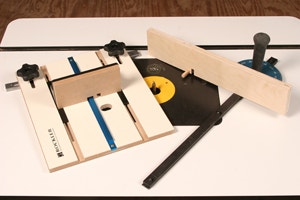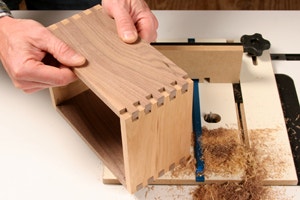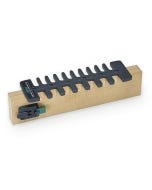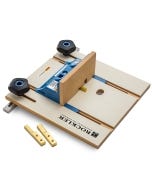Box Joints Possible with a Router Table?
So many projects call for joinery that may be quite simple, in fact so simple that some might not realize that those of us who haven't taken woodworking courses do not know how to perform it with a router table. Example: I don't believe I have ever read an article explain how to set up a router to make box joints. Question: Can and how would a router be utilized to make box joints for a project such as a toy chest? And what would be the best way to install the glue to assemble? - Willis Gray
Tim Inman: Box joints are not simple joints. Let me say that another way: The concept of a box joint is simple and straightforward. The execution of box joints is somewhat difficult. They can be hard to make; it takes a special jig. In fact, getting a box joint to fit properly is a lifetime quest for some woodworkers. To make a box joint requires a simple jig. Although it is straightforward and easy to make in your shop, it is a precision setup that requires some trial and error fitting before success is at hand. A router can certainly be used to cut box joints. I make most of my box joints with my table saw jig and a fine carbide saw blade because it is just so much faster for me to do - and my box joints are usually in projects that are more utilitarian than "fine" woodworking. A router would make the most perfect joints.
As for glue-up, I'm old school and probably at odds with others. I like to just get in there and get messy. As a kid, I heard my grandfather, my father and my uncle say so many times, "The glue on the floor is what sticks the joints together." They were trying to say that it was very important to them (and to the joints) that the entire wood surface of the mating pieces be covered in glue before we fit things together for final assembly. After assembly, we wiped down the excess squeeze-out and cleaned up. Many woodworkers object to cleaning up expressed glue. Some think it is wasteful. It isn't. The very best, strongest glue joints engage fully glue-wetted surfaces that mate closely together and are held tightly in place with clamping pressure. A small brush makes a great little tool to apply the glue.

Chris Marshall: It's definitely possible to make box joints on a router table. The process involves first making a modified fence with a protruding pin in it and attaching that to a miter gauge, then using the pin to index each cut as you slide the wood over the bit with the miter gauge. It's the same technique often used to cut box joints on a table saw with a dado blade, only on a router table you'll use a straight or spiral bit instead. There are various router table box joint jigs on the market that take the miter gauge out of the process. You can also use some dovetail jigs with a special box joint template and a handheld router. Space here doesn't allow me to discuss every step of the process for making box joints, but most books on router joinery will explain the procedure in detail. Make sure to dry-fit the joints first to be certain they'll go together correctly! If they slip together by hand with just a bit of wiggling to overcome the friction between parts, you've got a good fit. And when you're ready for assembly, you'll have to work at a good clip because you'll be dealing with a large surface area. Apply glue to both contact surfaces of the joints with a small paddle or brush. Some woodworkers use notched cauls that match the box joint pattern to help press the joints closed when clamping. It's a good idea: by the time you're pushing the parts together, the glue probably will be getting tacky.
Keep the inspiration coming!
Subscribe to our newsletter for more woodworking tips and tricks




